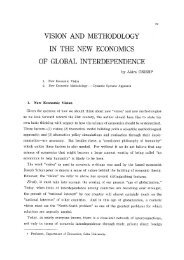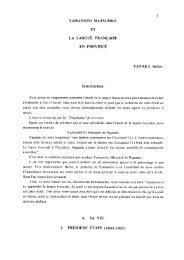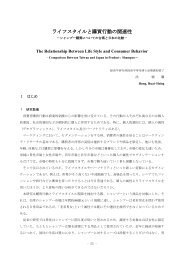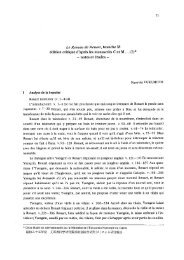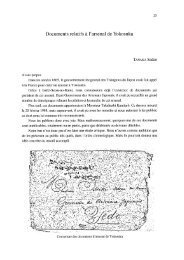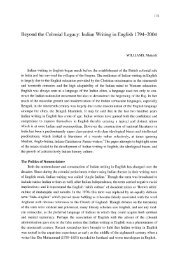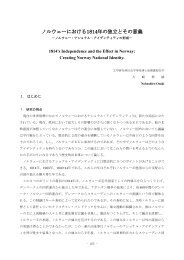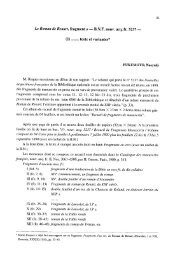New Historicism and Literary Studies - Soka University Repository
New Historicism and Literary Studies - Soka University Repository
New Historicism and Literary Studies - Soka University Repository
Create successful ePaper yourself
Turn your PDF publications into a flip-book with our unique Google optimized e-Paper software.
132<br />
Walter Cohen sees the new historicist reliance on "arbitrary connectedness" between different<br />
aspects of social reality as a significant lack of an "organizing principle."62<br />
Roger Kimball in Tenured Radicals: How Politics Has Corrupted Our Higher Education ,<br />
finds the tendency in new historicism <strong>and</strong> radical feminism to substitute sociology <strong>and</strong> ideology<br />
for literary criticism <strong>and</strong> literature somewhat irksome. "Is there something about the literary<br />
experience that transcends contingencies like time, race <strong>and</strong> sexual orientation?" And Kimball<br />
answers yes. The Western canon, which has been under assault by the 1960s radicals , is central<br />
to a complete liberal arts education in the United States, an education through which students<br />
can explore the profound dramas of life <strong>and</strong> seek answers to our existential dilemmas .63<br />
Dominick La Capra in Soundings in Critical Theory calls the method as "cut-<strong>and</strong>-paste<br />
bricolage."64 Education (literary criticism <strong>and</strong> literature including) has become an ideologically<br />
contested ground <strong>and</strong> the entire Western civilization a contentious area.<br />
Being a practice of literary criticism, new historicism has somehow failed to develop a<br />
sustained theory about its literary method or cultural model. Furthermore, the belief in arbitrary<br />
connectedness has led many practitioners of new historicism to assume that there is a natural<br />
inter-connectedness in social <strong>and</strong> literary realities rooted in the idea of cultural determinism .<br />
Cultural Poetics<br />
In Renaissance Self-Fashioning <strong>and</strong> later in Shakespearean Negotiations , Greenblatt<br />
defined his practice of cultural poetics as a study of "cultural practices understood to be art<br />
forms <strong>and</strong> other, contiguous, forms of expression" (p. 5).65 Granting autonomy to literary <strong>and</strong><br />
cultural histories, Greenblatt reorganized cultural poetics by emphasizing the inter-textuality of<br />
literature <strong>and</strong> society, which according to him arose out of an organically unified cultural<br />
system. He attempted to study the relations within the gr<strong>and</strong> structural enterprise rather than see<br />
the sequence of autonomy of various discourses. Greenblatt's argument about tropes<br />
functioning as both objects <strong>and</strong> conditions echo the views of Geertz <strong>and</strong> Foucault. Greenblatt<br />
explains:<br />
The relation I wish to establish between medical <strong>and</strong> theatrical practice is not one of<br />
cause <strong>and</strong> effect or source <strong>and</strong> literary realization. We are dealing rather with a shared<br />
code, a set of interlocking tropes <strong>and</strong> similitudes that function not only as objects but as the<br />
conditions of representation.66<br />
The anti-historicist idea of dealing with "a shared code" in medical <strong>and</strong> theatrical practices<br />
takes its cue from Geertz's notion of collective <strong>and</strong> symbolic cultural system <strong>and</strong> Foucault's<br />
epistemic rather than causal construction of history.<br />
In an essay "Return to History" published in Aesthetics, Method <strong>and</strong> Methodology ,<br />
Foucault rejects historical causality in order to seek discontinuity <strong>and</strong> to find the emergence<br />
<strong>and</strong> center of an event. He concludes:<br />
Structuralism, by defining transformations, <strong>and</strong> history, by describing types of events<br />
<strong>and</strong> different types of duration [duree], make possible both the appearance of<br />
discontinuities in history <strong>and</strong> the appearance of regular, coherent transformations .



